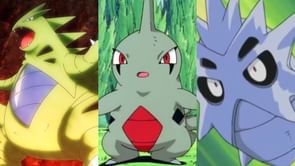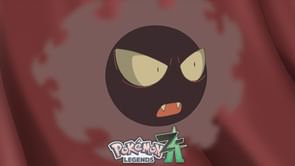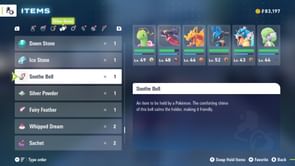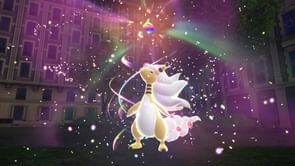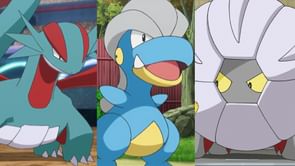Introduced in generation one, with the original Pokemon Red, Blue, and Green games, Cloyster is a dual type water and ice Pokemon. It is the final evolution of Shellder and evolves once a Water Stone is used. Cloyster is classified as the “Bivalve Pokemon” which may be a nod to its resemblance to mollusks. This guide will showcase Cloyster’s capabilities in battle, its appearances in the anime, as well as other general facts about Cloyster.

About Cloyster
As one of the original 151 Pokemon from generation one, Cloyster first appeared in the original series in the episode The Bridge Bike Gang. While its role in this episode is minor, it showcased the trouble that Misty has with her Psyduck throughout the series. Cloyster is part of a two stage evolution and evolves from Shellder when a Water Stone is used. The Pokedex states that Cloyster’s shell is used as a weapon as well as being impossible to open, which further supports its defensive capabilities as well as its real life connection to mollusks.
| First appearance in anime | Pokemon the Original Series The Bridge Bike Gang |
| First appearance in game | Red/Green (Japan) Red/Blue (International) |
| Region | Kanto |
| Evolution | Final evolution of Shellder |
| 1st Evo level | Evolves from Shellder when exposed to a Water Stone |
| 2nd Evo level | N/A |
| Pokedex Entry | Its shell is so hard, it can even withstand a bomb. No one has ever seen what is inside its shell. |
Cloyster Base Stats
| HP | 50 |
| ATTACK | 95 |
| DEFENCE | 180 |
| SP. ATTACK | 85 |
| SP. DEFENCE | 45 |
| SPEED | 70 |
| TOTAL | 525 |
Appearance
Cloyster is a black, round, ball-like Pokemon with a spiky shell and it has two eyes plus a mouth on its black body. Like mollusks or other clams, Cloyster can shut its shell and put up an impressive defense as most of the shell is ridged and spiked. It has, what looks like, two shells with the inner shell light gray in color and a blue-violet outer shell. It is quite large for a mollusk at 4 feet and 11 inches, or 1.5 meters, tall and has one barbed spike sticking out from the inner shell.

Behavior
Most of what we know about Cloyster’s behavior is through Elite Four member Lorelei and the Pokedex. Despite being a generation one Pokemon, it has only played a minor role over the course of the entire series. It is shown to be a loyal Pokemon to Lorelei and follows its trainers commands without any problem. The Pokedex states that Cloyster lives in harsh seas to sharpen the spikes on its shell.
Strengths and Weaknesses
While most of Cloyster’s stats are mediocre, you would be hard pressed to find a Pokemon with a higher base physical defense stat. Cloyster’s physical defense is excellent and along with the ability, Skill Link, its attacks can deal a lot of damage. As a dual type water/ice type Pokemon, Cloyster is weak to fighting, rock, grass, and electric type moves, not immune to any types but is resistant to water and ice type moves.
Best Moveset
Cloyster can be used as an offensive role thanks to its ability Skill Link. Its multi-hitting moves along with King’s Rock, as a held item, can make for a very offensively capable Pokemon. On top of this, Cloyster is one of the only Pokemon capable of utilizing Shell Smash to sacrifice its own defensive stats for one of the fastest setup tools in the game. Consider running Shell Smash, Icicle Spear, Rock Blast, and Ice Shard/Razor Shell. Shell Smash is a must to ensure that Cloyster becomes a threat, Icicle Spear benefits from STAB (Same Type Attack Bonus), and Rock Blast is for type coverage. Finally, Ice Shard can be used as a priority move while Razor Shell can help you get through bulkier Pokemon.
| Shell Smash | Icicle Spear |
| Rock Blast | Ice Shard/Razor Shell |
How to Catch Cloyster in Pokemon Go
If you would like to obtain a Cloyster in Pokemon Go, the easiest way would be to obtain a Shellder and eventually evolve it into a Cloyster. That is because it is easier to encounter a Shellder in the wild as compared to its final evolution. Finding a Shellder means that you can collect enough candies by using it as your buddy or by capturing enough Shellders. You will need 50 Shellder candies in order to evolve into Cloyster. If you want to skip collecting candies, you can also find Cloyster in tier two Pokemon Gym raids, so keep an eye out.
Trivia
- The name Cloyster is likely a combination of the words clam and oyster while also being a play on cloister.
- The inspiration for Cloyster’s design likely comes from the Spondylus bivalve.
- Cloyster has one of the highest base defense stats of all the water type Pokemon in the game, tied with only Slowbro’s Mega Evolution.
Video
FAQ
Can Cloyster evolve?
Cloyster is part of a two stage evolution and is the final evolution of its pre-evolution Shellder, which means that it does not evolve further. It also does not have a unique Gigantamax form or a mega evolution either which makes Cloyster the best you can get out of the Shellder evolution line.
Why does Cloyster look like Gastly?
There is likely no intentional connection between Cloyster and Gastly. You can only draw a sinister looking face on a black ball so many times before they begin to look alike. Within both Pokemon’s lore, there is no mention of the other which means that any resemblance is likely coincidental.
What Pokedex Number is Cloyster?
Cloyster is Pokemon #091. The Pokedex will label every Pokemon with a number typically sequentially with its evolutions. However, Pokemon that were released in a prior generation will gain priority over sequential order with evolutions. Therefore, you can use this number to remind yourself which generation a Pokemon was released in.
Conclusion
Congratulations, you now know just about everything there is to know about this “Bivalve Pokemon”. Cloyster has been in the competitive play limelight ever since its introduction in the original generation one games. It is difficult to get through Cloyster’s bulk as well as handle its general strategy. Reserve a slot on your team for Cloyster and you’ll get one of the most defensive Pokemon in the game.
